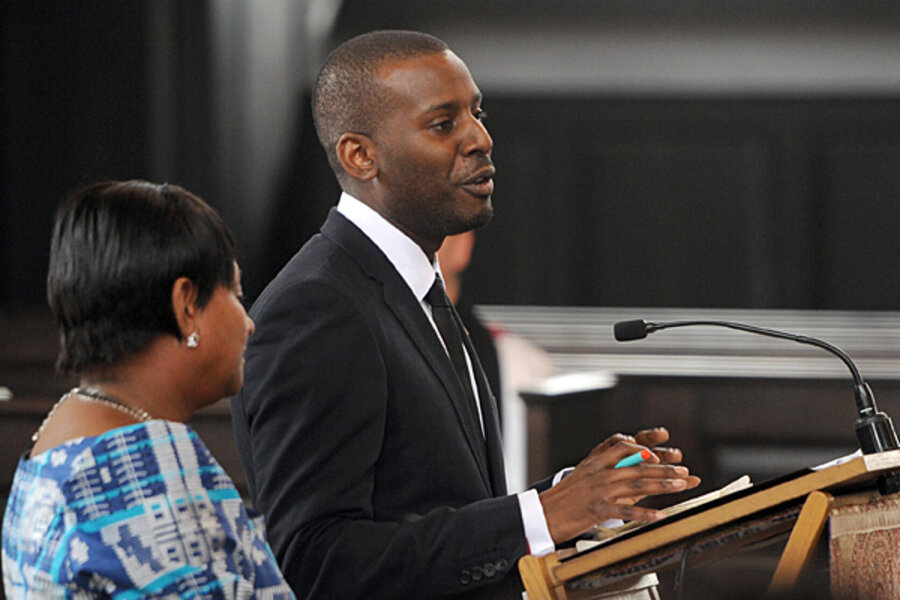After London murder, an effort to smear victim's family?
Loading...
| London
Calls for a wide-ranging public inquiry into police ethics and practices were mounting today in the United Kingdom following claims by a former undercover policeman that Britain’s largest force once sought to smear the family of one of the highest profile victims of racial violence.
The controversy comes more than 20 years after a black teenager, Stephen Lawrence, was stabbed to death in an unprovoked attack by a gang of white youth in southeast London. A public inquiry later accused London’s Metropolitan Police Service, or the Met, of “institutional racism” and identified major failings in how it investigated the murder. Two men were convicted of the crime last year.
Now, despite changed policies and concerted efforts to recruit minorities into the police force, a case that has long weighed heavily on the Met is once again leading to awkward questions about its attitude toward race relations.
“This killing is, and remains, an open wound in London,” says Les Back, a professor of sociology at Goldsmiths, University of London.
This week, the outrage over the case was revisited when a former undercover officer revealed that the police hunted for information to smear the victim’s family during the investigation into Mr. Lawrence’s death. Neville Lawrence, the victim’s father, and others called for a public inquiry into the claim.
Peter Francis, a police officer who infiltrated antiracism groups in the 1990s, alleges that his police superiors feared that anger at police failure to investigate Lawrence killing would fuel unrest in the way that the beating of Rodney King by police in Los Angeles was a spark for the 1992 riots there.
Mr. Francis told a joint investigation by Britain’s Guardian newspaper and Channel 4 television that he had been ordered to "hunt for disinformation" that might be used to undermine the campaign waged by the victim’s family and supporters.
"Throughout my deployment there was almost constant pressure on me personally to find out anything I could that would discredit these campaigns," said Francis, who added that superiors withheld his role from the judge who ruled in a 1999 inquiry that the police investigation had been "marred by a combination of professional incompetence, institutional racism and a failure of leadership by senior officers."
According to Mr. Back, the judge addressed some of the issues arising from the case, but many that remained dormant are now emerging.
“What we are seeing now, and what we will see more of, is details of the police inability to really face the violence an injustice of the murder and their capacity to try to treat the victims as a problem which I think is a legacy of the Met’s history of their relations with the black communities in London and the kinds of policing that took place in the '70s, '80s and up to the '90s,” Back says.
'A deeper level'
Whatever investigation takes place into the allegations by Francis – who also claims police spied on critics of police corruption – the London police seem set for a bout of intense media scrutiny about its attitude towards race relations and its own diversity.
The force has long been criticized for using "stop and search" tactics with citizens on the street. Statistics have consistently shown that black and Asian Britons are more likely to be stopped than white people.
The Met compares well with other police forces in the UK and in Europe in terms of its attempts to modernize and overhaul policies in the sphere of race relations, says Karim Murji, a sociologist who has researched issues around policing, diversity, and race.
“My impression is that the police force now is not the same as it was in the '80s,” says Mr. Murji, a lecturer at the Open University who also served on the supervisory board for the Met. He says clumsy communication is to blame for many of the Met’s controversies.
He cites a blunt 1995 statement by the Met’s then commissioner, Paul Condon, who said that 80 percent of muggings in high crime areas of London were committed by young black men.
“It does look different as a force today. Having said that, some of the same thematic issues and complaints continue to occur, particularly around stop and search and policing of young black people, as well as other young people,” Murji says.
“The question is have they changed not just superficially, but also at a deeper level.”








